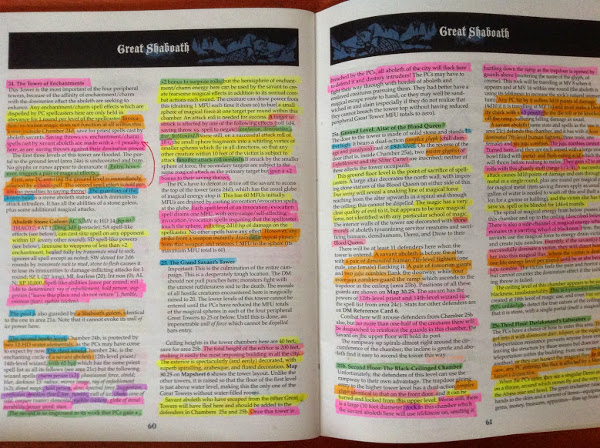The copy I acquired has been lovingly used. And by that, I mean the owner really liked highlighting text:
Every page looks like that. My reaction upon seeing it was twofold:
- When you reach a point when there’s more highlighted text on a page than non-highlighted text, have you defeated the purpose of highlighting?
- Why doesn’t every game book look this colorful?
I’ll be honest: I love this. (Here’s another example of the sort of awesome gaming artifacts you find in old boxed sets, if you’re lucky.) Back in the day, I was pretty neurotic about keeping my books and game material in pristine, mint condition. But a banged-up, highlighter-inundated, notes-scrawled-in-the-margins game book like this has been played, and that’s a lot more fun than a perfect-condition rulebook that looks like nobody’s ever so much as opened it.
The owner of this copy of Night Below didn’t just read through it and highlight interesting items; he/she and their game group played the heck out of it. You can tell they played through it in its entirety, because all the way to the end, the encounter descriptions are marked up with notes that must have originated from actual play. Here, for example, is a description of one of the final “boss battles;” you can see that the DM has jotted down ever-decreasing hit points in the margins, and has crossed out spells that have been cast:
There’s a thrill in holding—and, I hope, one day playing!—a game that was important to real, actual gamers before me. A campaign like this might have taken months or years to play through. The DM must have spent hours and hours pouring through this campaign planning each new game session, marking up important parts of the text with a color-coding system that made sense to them but not to me (the same color is used in some places to mark spells, in others to mark hit points—it’s madness, but a madness that meant something to somebody). Perhaps the players still recount stories and anecdotes from it to this day.
 And having provided hundreds of hours of collective entertainment, how did this boxed set wind up being sold on the internet for a few measly bucks? Surely there’s a story there too, of a hobby abandoned, a game group graduating and getting married and heading to different corners of the country, a family clearing out a garage storage bin after a death, or whatever else you might imagine.
And having provided hundreds of hours of collective entertainment, how did this boxed set wind up being sold on the internet for a few measly bucks? Surely there’s a story there too, of a hobby abandoned, a game group graduating and getting married and heading to different corners of the country, a family clearing out a garage storage bin after a death, or whatever else you might imagine.
There’s also a bit of a rebuke in a heavily-used game like this: why aren’t more of my games lovingly defaced like this? As I look through my collection and ponder trimming it down, I see too many books in great condition, and not enough books with cracked spines and falling-out pages caused by years of regular use at the gaming table.
So here’s to the anonymous Dungeon Master and their players, who adventurered their way through this campaign all the way to the end. And left behind lots of mile markers for me to follow.















